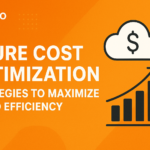Microsoft Azure offers powerful scalability and flexibility, but without careful management, cloud expenses can escalate quickly. Azure cost optimization is the process of strategically managing and reducing your cloud costs while maintaining performance and compliance. For businesses relying on Azure, mastering this balance can result in significant savings and long-term efficiency.
In this guide, we’ll explore practical Azure cost optimization strategies—covering rightsizing, monitoring, automation, and governance—to help your business get the most value out of every dollar spent in the cloud.
Why Azure Cost Optimization Matters
Cloud computing has transformed how businesses operate, but the pay-as-you-go model can easily lead to overspending. Studies show that up to 30% of cloud spend is wasted due to unused or misconfigured resources (source: Flexera 2024 State of the Cloud Report).
Azure cost optimization isn’t just about cutting expenses; it’s about improving visibility, predictability, and return on investment. With the right strategy, you can:
- Identify underutilized or idle resources
- Optimize workloads for performance and cost
- Forecast expenses accurately
- Reinvest savings into innovation and growth
Key Strategies for Azure Cost Optimization
1. Rightsize Your Resources
Rightsizing ensures that you’re not paying for more capacity than you need. Azure provides tools like Azure Advisor and Cost Management + Billing to analyze usage patterns and recommend appropriate configurations.
Action Steps:
- Review virtual machine (VM) performance metrics
- Downsize or switch to reserved instances when suitable
- Remove or stop underused instances during off-hours
Rightsizing alone can reduce cloud costs by up to 20–30% without impacting performance.
2. Use Azure Reserved Instances and Savings Plans
Azure Reserved Instances (RIs) allow you to commit to using certain VM types for one or three years in exchange for discounts of up to 72%. Similarly, Azure Savings Plans provide flexible pricing options across multiple computer services.
Best Practices:
- Evaluate your long-term workloads for predictability
- Combine RIs with pay-as-you-go for flexible scaling
- Monitor usage regularly to adjust commitments
These options are ideal for steady-state workloads such as databases or internal applications.
3. Automate Cost Management
Automation is central to efficient cloud cost control. Azure offers tools like Azure Automation, Logic Apps, and Azure Functions to schedule and automate resource management.
Examples of automation tasks:
- Automatically shut down test or development VMs after business hours
- Set alerts for budget thresholds
- Deallocate unused resources
Automating these tasks ensures consistent compliance with your cost policies—without manual oversight.
4. Monitor and Analyze Cloud Usage
Visibility is key to effective cost optimization. Azure’s Cost Management + Billing dashboard allows organizations to track spending patterns, allocate budgets, and identify anomalies in near real-time.
Tips for better monitoring:
- Set up tagging policies for departments or projects
- Analyze cost trends monthly
- Use Azure Budgets to trigger alerts before overspending
With these insights, IT teams can make informed decisions that align with both operational and financial goals.
5. Optimize Storage and Data Management
Storage can be one of the most overlooked sources of waste. Azure offers multiple storage tiers—Hot, Cool, and Archive—each priced differently based on access frequency.
Optimization methods:
- Move infrequently accessed data to lower-cost tiers
- Enable lifecycle management policies
- Compress or delete obsolete backups
This ensures you’re paying only for what you truly need, helping lower total ownership costs.
6. Implement Governance and Policies
Governance is the backbone of long-term Azure cost control. Without clear policies, even optimized environments can quickly drift into inefficiency.
Effective governance practices include:
- Enforcing resource tagging for accountability
- Setting role-based access control (RBAC) to prevent resource sprawl
- Regular audits and budget reviews
Adopting a FinOps (Financial Operations) approach encourages collaboration between IT, finance, and business teams to maintain ongoing optimization.
7. Leverage Managed Services
For businesses without in-house Azure experts, partnering with a managed IT service provider can simplify the process. Managed providers offer proactive monitoring, continuous optimization, and strategic guidance.
For instance, Solzorro’s Azure & SharePoint Services help organizations streamline their cloud operations, ensure compliance, and reduce costs through professional Azure management.
By leveraging expert insights, companies can prevent misconfigurations, improve utilization, and maintain financial efficiency.
8. Regularly Review and Update Your Strategy
Cloud environments are dynamic. What works today might not be cost-effective tomorrow. Establish a routine review—quarterly or bi-annually—to reassess your Azure usage, performance, and pricing models.
Use the findings to:
- Decommission unused resources
- Reallocate budgets based on updated workloads
- Integrate new Azure cost-saving tools or features
Continuous improvement ensures your optimization efforts evolve with your business.
FAQs About Azure Cost Optimization
Q1: What is Azure cost optimization?
Azure cost optimization is the ongoing process of monitoring, managing, and reducing Azure expenses by aligning resource usage with actual business needs.
Q2: How can I reduce my Azure VM costs?
You can reduce costs by rightsizing VMs, using reserved instances, automating shutdowns, and eliminating idle or duplicate instances.
Q3: What tools does Azure offer for cost management?
Azure provides Cost Management + Billing, Azure Advisor, and Azure Automation tools for budgeting, recommendations, and automated cost control.
Q4: Is it possible to automate Azure cost-saving tasks?
Yes. With tools like Azure Automation and Logic Apps, you can schedule tasks like stopping unused VMs and setting budget alerts.
Q5: Why should I partner with a managed service provider?
A managed provider like Solzorro ensures continuous monitoring, advanced optimization, and compliance—freeing your team to focus on innovation.
Conclusion
Azure cost optimization isn’t a one-time task—it’s a continuous process of balancing performance, flexibility, and financial control. By combining rightsizing, automation, monitoring, and governance, businesses can unlock the full value of Azure while keeping costs predictable and sustainable.
Whether you manage Azure internally or through a trusted partner like Solzorro, the goal remains the same: achieve cloud excellence through smart, data-driven decisions.

